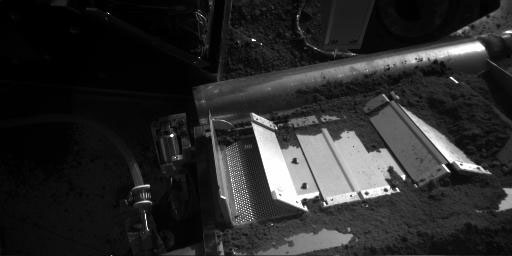Mars Lander Samples All Layers of Surface

NASA's Phoenix Mars Lander has scooped up another sample of Martian dirt into one of its onboard laboratory ovens. The sample will complete a profile of all depths of the surface layer of Phoenix's arctic landing site.
The lander's robotic arm collected the sample, dubbed Burning Coals, from a trench informally named Burn Alive 3. The sample comes from an intermediate depth between the surface regolith and the rock-hard subsurface icy layer, which Phoenix confirmed was water ice on July 31.
The $420 million Phoenix mission is analyzing the surface material in the Martian arctic too look for signs of potential past habitability. The mission was originally slated to last for three months, ending at the close of August, but NASA has extended the mission through the end of September.
Early on Thursday, mission controllers received information from Phoenix that confirmed that some of the Burning Coals sample had been delivered through the doors of cell number 7 of the lander's Thermal and Evolved-Gas Analyzer (TEGA), almost completely filling the cell. TEGA heats up samples and then analyzes the vapors given off to determine the composition of the surface material.
TEGA won't begin heating a sample on its own unless it senses the oven is completely full, so the Phoenix science team will command the oven door to close and the cell will begin heating the sample. TEGA scientists have sent commands to manually close oven doors before.
The sample will first be heated to relatively low temperatures, around 95 degrees Fahrenheit (35 degrees Celsius) so that it can detect any water vapor given off by melting ice that might be in the sample. The oven will then heat up to 257 F (125 C) to ensure that the sample is dry. The last step of the heating process pushes the temperature up to 1,832 F (1,000 C) so that the instrument can detect any gases given off to help the science team determine the specific properties of the Martian dirt.
One particular signal the Phoenix team will be looking for is that of perchlorate, a highly oxidizing substance that is also soluble and was detected in samples delivered to the lander's wet chemistry lab. Seeing signs of perchlorate in TEGA would help confirm that wet lab finding.
Breaking space news, the latest updates on rocket launches, skywatching events and more!
"We are expecting the sample to look similar to previous samples," said William Boynton of the University of Arizona, lead scientist for TEGA. "One of the things we'll be looking for now is an oxygen release indicative of perchlorate."
This new sample completes a three-level profile of the Martian dirt that also includes surface material from a trench called Rosy Red and ice-layer material from a trench called Snow White.
"We want to know the structure and composition of the soil at the surface, at the ice and in-between, to help answer questions about the movement of water -- either as vapor or liquid -- between the icy layer and the surface," said Ray Arvidson of Washington University in St. Louis, a leader of Phoenix science team activities.
Join our Space Forums to keep talking space on the latest missions, night sky and more! And if you have a news tip, correction or comment, let us know at: community@space.com.

Andrea Thompson is an associate editor at Scientific American, where she covers sustainability, energy and the environment. Prior to that, she was a senior writer covering climate science at Climate Central and a reporter and editor at Live Science, where she primarily covered Earth science and the environment. She holds a graduate degree in science health and environmental reporting from New York University, as well as a bachelor of science and and masters of science in atmospheric chemistry from the Georgia Institute of Technology.
